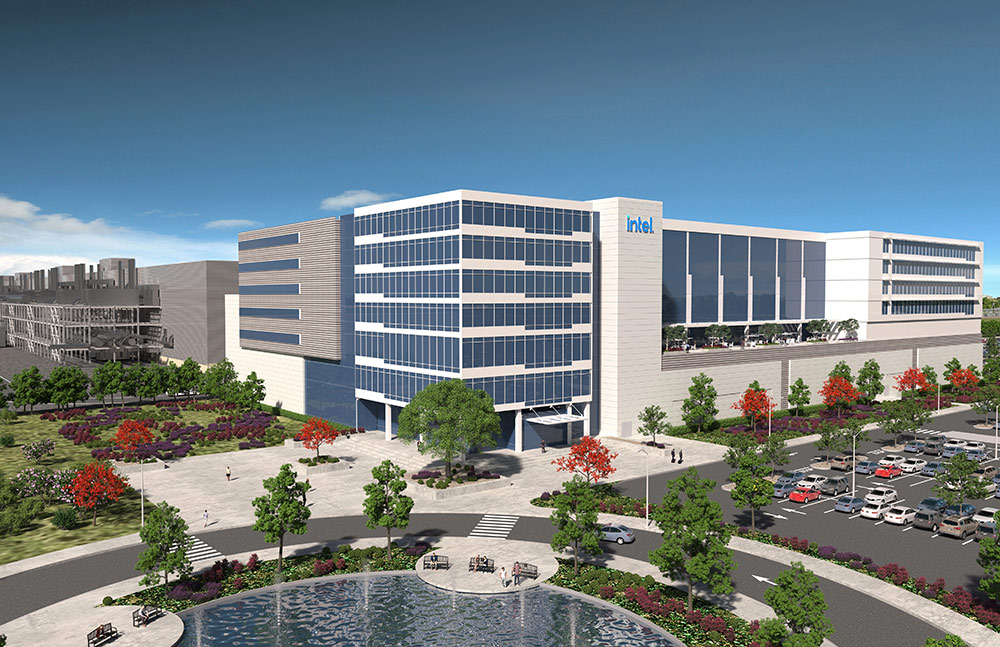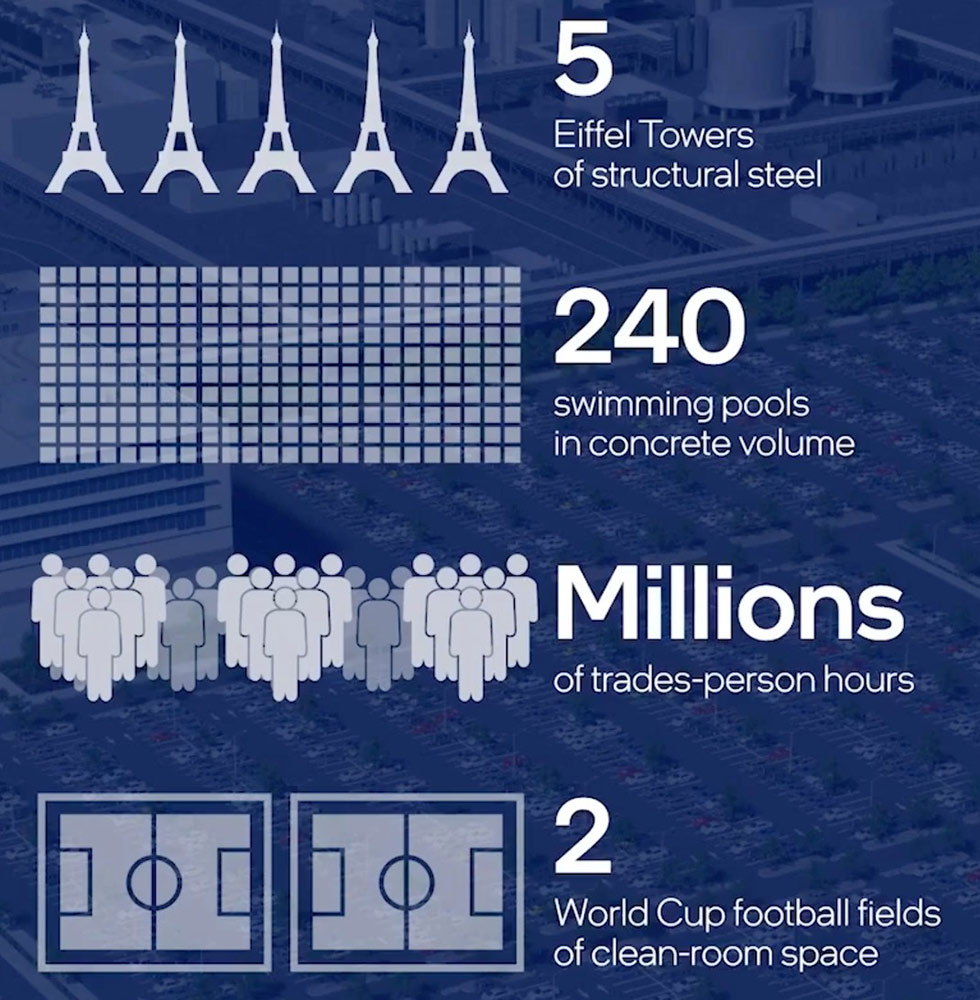美国芯片巨头英特尔公司(Intel)选址德国打造未来大型新工厂,旨在恢复其曾经在全球半导体行业占主导地位的声誉。
英特尔公司仍然有许多有待改进的地方。在2021年的芯片危机——严重的半导体短缺——之后,美国和欧洲政府希望补贴芯片投资,英特尔公司的首席执行官帕特·基辛格抓住了两国政府提供的机会。
“如今,80%的芯片是由亚洲生产的。”3月15日,帕特·基辛格宣布计划明年上半年在德国投资170亿欧元打造芯片工厂,如果补贴批准允许的话,“我们具有里程碑意义的泛欧投资就能够满足全球对更为平衡、更具弹性的供应链的需求。”
如果包括扩建爱尔兰现有工厂和计划在意大利建立的另一个工厂,英特尔公司的投入就将超过330亿欧元,并在欧盟范围内雇佣至少5500名新员工,这仅仅只是一个开始。总而言之,英特尔公司设想在未来十年为其欧盟业务投入800亿欧元。
3月15日,英特尔的首席执行官说:“世界对半导体的需求永不满足。这是一个整体的投资策略,英特尔将创建横跨整个欧洲的世界级芯片生态系统。”

随着人们的需求从台式电脑转向电池供电的智能手机和其他移动设备,而这些移动设备需要比其自身的x86架构更节能的电路设计,英特尔才发现自己在过去十年中落后于竞争对手。
为了提高利润和降低风险,包括英伟达(Nvidia)在内的众多竞争对手选择将资本密集型芯片生产外包给称为代工厂的独立专业公司,例如台湾积体电路制造股份有限公司(以下简称“台积电”)(TSMC)。还有一些公司将他们的半导体制造设施或“工厂”分拆成独立的公司进行剥离,比如超微半导体公司(Advanced Micro Devices)。
英特尔认为,在当前半导体短缺的情况下,其制造能力和现有的芯片工厂网络成为竞争优势。然而,英特尔,这一让硅谷名声大噪的公司并不具备打印世界上最先进晶体管的技术。这一技术只有亚洲的台积电和三星(Samsung)掌握。
英特尔的市值约为英伟达或台积电的三分之一。帕特·基辛格于2021年年初加入英特尔,他的目标是让英特尔重现昔日辉煌。
今年1月,英特尔表示在一个月后同意斥资54亿美元收购以色列的Tower Semiconductor之前,将投资200亿美元在美国的俄亥俄州新建一座领先的大型工厂,这些举措都是与无工厂竞争对手和代工厂竞争的计划的一部分。
如今,英特尔选址曾经是东德的一个经济萧条区来打造第二大领先的大型工厂,据称该工厂一旦在2027年投产,就会成为世界上最先进的工厂。马格德堡附近1000公顷的地区最多可以容纳八家互联芯片工厂,这预示着未来将有进一步投资。
英特尔不愿就其为创造3000个全职工作岗位而预期获得的补贴的具体细节发表评论,但帕特·基辛格曾经说过补贴大约80亿欧元。考虑到特斯拉(Tesla)为获得柏林附近格伦海德工厂的许可而经历的官僚主义繁文缛节,英特尔的做法可能让德国获利,从而让一切顺利进行。

英特尔并没有止步于德国。
帕特·基辛格将在法国成立一个新的欧洲总部,主攻高性能计算和人工智能,并向爱尔兰现有的莱克斯利普(Leixlip)工厂投入120亿欧元。英特尔可能会向意大利总装厂进一步投资45亿欧元,组装工作通常留给低工资国家,以保持成本竞争优势。
然而,日本晶圆厂发生火灾,新冠疫情爆发影响马来西亚包装设施的产量,半导体短缺影响了供应链的两个部分。
因此,欧盟在 2 月公布了新的《欧洲芯片法案》(European Chips Act),解除了国家补贴限制,鼓励像英特尔这样的新投资,以确保未来更大程度上的自给自足。
欧盟委员会主席乌尔苏拉·冯德莱恩在一份录音声明中表示:“我认为英特尔今天宣布未来十年里将在整个半导体价值链投资800亿欧元,涉及从研发到制造和先进包装的方方面面,这一宣布是《欧盟芯片法案》实施后取得的第一项重大成就。”
与此同时,英国在高调脱欧后(Brexit)被冷落,没有一英镑的投资,这证实了帕特·基辛格在2021年9月接受《财富》杂志采访时做出的预测。(财富中文网)
译者:ZHY
美国芯片巨头英特尔公司(Intel)选址德国打造未来大型新工厂,旨在恢复其曾经在全球半导体行业占主导地位的声誉。
英特尔公司仍然有许多有待改进的地方。在2021年的芯片危机——严重的半导体短缺——之后,美国和欧洲政府希望补贴芯片投资,英特尔公司的首席执行官帕特·基辛格抓住了两国政府提供的机会。
“如今,80%的芯片是由亚洲生产的。”3月15日,帕特·基辛格宣布计划明年上半年在德国投资170亿欧元打造芯片工厂,如果补贴批准允许的话,“我们具有里程碑意义的泛欧投资就能够满足全球对更为平衡、更具弹性的供应链的需求。”
如果包括扩建爱尔兰现有工厂和计划在意大利建立的另一个工厂,英特尔公司的投入就将超过330亿欧元,并在欧盟范围内雇佣至少5500名新员工,这仅仅只是一个开始。总而言之,英特尔公司设想在未来十年为其欧盟业务投入800亿欧元。
3月15日,英特尔的首席执行官说:“世界对半导体的需求永不满足。这是一个整体的投资策略,英特尔将创建横跨整个欧洲的世界级芯片生态系统。”
随着人们的需求从台式电脑转向电池供电的智能手机和其他移动设备,而这些移动设备需要比其自身的x86架构更节能的电路设计,英特尔才发现自己在过去十年中落后于竞争对手。
为了提高利润和降低风险,包括英伟达(Nvidia)在内的众多竞争对手选择将资本密集型芯片生产外包给称为代工厂的独立专业公司,例如台湾积体电路制造股份有限公司(以下简称“台积电”)(TSMC)。还有一些公司将他们的半导体制造设施或“工厂”分拆成独立的公司进行剥离,比如超微半导体公司(Advanced Micro Devices)。
英特尔认为,在当前半导体短缺的情况下,其制造能力和现有的芯片工厂网络成为竞争优势。然而,英特尔,这一让硅谷名声大噪的公司并不具备打印世界上最先进晶体管的技术。这一技术只有亚洲的台积电和三星(Samsung)掌握。
英特尔的市值约为英伟达或台积电的三分之一。帕特·基辛格于2021年年初加入英特尔,他的目标是让英特尔重现昔日辉煌。
今年1月,英特尔表示在一个月后同意斥资54亿美元收购以色列的Tower Semiconductor之前,将投资200亿美元在美国的俄亥俄州新建一座领先的大型工厂,这些举措都是与无工厂竞争对手和代工厂竞争的计划的一部分。
如今,英特尔选址曾经是东德的一个经济萧条区来打造第二大领先的大型工厂,据称该工厂一旦在2027年投产,就会成为世界上最先进的工厂。马格德堡附近1000公顷的地区最多可以容纳八家互联芯片工厂,这预示着未来将有进一步投资。
英特尔不愿就其为创造3000个全职工作岗位而预期获得的补贴的具体细节发表评论,但帕特·基辛格曾经说过补贴大约80亿欧元。考虑到特斯拉(Tesla)为获得柏林附近格伦海德工厂的许可而经历的官僚主义繁文缛节,英特尔的做法可能让德国获利,从而让一切顺利进行。
英特尔并没有止步于德国。
帕特·基辛格将在法国成立一个新的欧洲总部,主攻高性能计算和人工智能,并向爱尔兰现有的莱克斯利普(Leixlip)工厂投入120亿欧元。英特尔可能会向意大利总装厂进一步投资45亿欧元,组装工作通常留给低工资国家,以保持成本竞争优势。
然而,日本晶圆厂发生火灾,新冠疫情爆发影响马来西亚包装设施的产量,半导体短缺影响了供应链的两个部分。
因此,欧盟在 2 月公布了新的《欧洲芯片法案》(European Chips Act),解除了国家补贴限制,鼓励像英特尔这样的新投资,以确保未来更大程度上的自给自足。
欧盟委员会主席乌尔苏拉·冯德莱恩在一份录音声明中表示:“我认为英特尔今天宣布未来十年里将在整个半导体价值链投资800亿欧元,涉及从研发到制造和先进包装的方方面面,这一宣布是《欧盟芯片法案》实施后取得的第一项重大成就。”
与此同时,英国在高调脱欧后(Brexit)被冷落,没有一英镑的投资,这证实了帕特·基辛格在2021年9月接受《财富》杂志采访时做出的预测。(财富中文网)
译者:ZHY
Intel has picked Germany as the future site for a massive new factory aimed at reestablishing the once dominant U.S. chipmaker’s reputation in the global semiconductor industry.
The company has a lot of ground to catch up on, and chief executive Pat Gelsinger has seized with both hands the opportunity offered by governments in the U.S. and Europe that want to subsidize chip investments following the chips crisis of last year—a crippling semiconductor shortage.
“Today 80% of chips are produced in Asia,” he said on March 15, after announcing plans to break ground on a €17 billion site in Germany in the first half of next year, subsidy approval permitting. “Our landmark, pan-European investment addresses the global need for a more balanced and resilient supply chain.”
When including an expansion at its existing plant in Ireland and a further site planned in Italy, the company will splash out more than €33 billion in combined spending and employ at least 5,500 new staff across the EU, just for starters. All told, it envisions plowing up to €80 billion into its EU operations over the next decade.
“The world has an insatiable demand for semiconductors,” the Intel CEO said on March 15. “This is a holistic investment strategy, and it will create a world-class chip ecosystem that spans all of Europe.”
With the shift away from desktop PCs toward battery-powered smartphones and other mobile devices that require a more energy-efficient circuit design than its own x86 architecture, Intel found itself falling behind the competition over the past decade.
To boost profits and minimize risk, numerous rivals including Nvidia chose to outsource capital-intensive chip production to independent specialists called foundries, such as Taiwan’s TSMC. Still others spun off their semiconductor fabrication facilities, or “fabs,” into separate companies for divestment, for example Advanced Micro Devices.
Intel believes its manufacturing prowess and existing network of chip fabs gives it a competitive edge in the current shortage. Yet the company that put Silicon Valley on the map does not possess the skill to print the world’s most advanced transistors; that has been mastered only by TSMC and Samsung in Asia.
With its market cap about a third of either Nvidia or TSMC, Gelsinger was brought on board early last year with a mandate to return Intel to its former glory.
In January, Intel said it would invest $20 billion in a new leading-edge megafab in Ohio, before agreeing a month later to spend $5.4 billion to acquire Israel’s Tower Semiconductor, as part of a plan to compete with both fabless rivals and foundries alike.
Now it has picked an economically depressed area in what was once East Germany as the site for its second leading-edge megafab, billed at being the most advanced in the world once it starts production in 2027. The almost 1,000-hectare area near Magdeburg offers space for up to eight connected chip factories, signaling further investments down the road.
Intel wouldn’t comment on the specifics of the subsidy it expects to receive in exchange for creating 3,000 full-time jobs, but Gelsinger has spoken about €8 billion in the past. That might have helped grease the wheels in Germany’s favor, given all the bureaucratic headaches Tesla went through to get permission for its Grünheide factory near Berlin.
Intel isn’t stopping at Germany, either.
Gelsinger will build a new European headquarters for high-performance computing and artificial intelligence in France and plow €12 billion into its existing Leixlip fab in Ireland. It may invest a further €4.5 billion in a final assembly site in Italy, work typically reserved for low-wage countries in order to remain cost competitive.
The semiconductor shortage, however, affected both parts of the supply chain, with fires breaking out in wafer fabs in Japan and COVID outbreaks hurting output in packaging facilities in Malaysia.
As a result, the EU unveiled its new European Chips Act in February, taking a crowbar to its state subsidy restrictions to encourage new investments like Intel’s that ensure greater self-sufficiency going forward.
“I see today’s announcement by Intel as the first major achievement under the EU Chips Act, an €80 billion investment over the next decade across the entire semiconductor value chain from R&D to manufacturing and advanced packaging,” European Commission President Ursula von der Leyen said in a recorded statement.
Meanwhile, the U.K. has been left out in the cold following its high-profile Brexit from the EU with not a pound of investment, confirming a prediction Gelsinger gave to Fortune in an interview in September.






